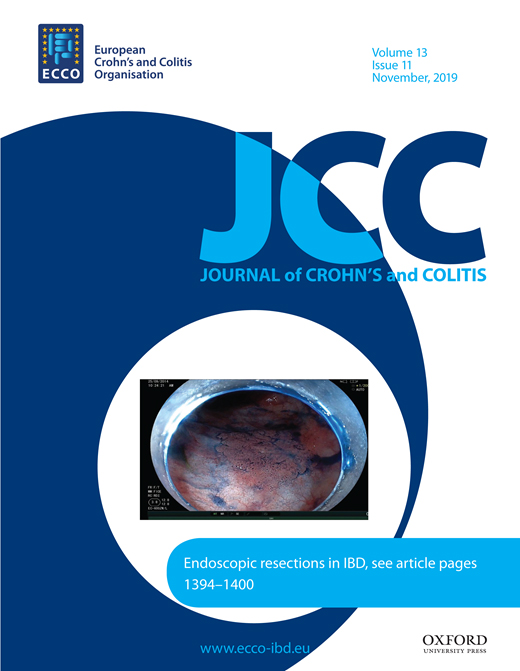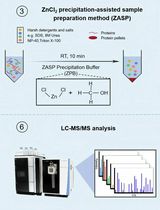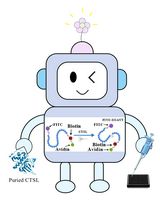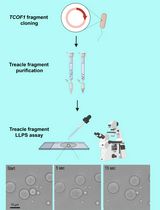- EN - English
- CN - 中文
Isolation and Characterization of Exosomes from Mouse Feces
小鼠粪便中外泌体的分离和鉴定
发布: 2020年04月20日第10卷第8期 DOI: 10.21769/BioProtoc.3584 浏览次数: 7527
评审: Meenal SinhaMarieta RusevaAnonymous reviewer(s)
Abstract
Exosomes secreted by colonic epithelial cells are present in feces and contain valuable epigenetic information, such as miRNAs, proteins, and metabolites. An in-depth study of this information is conducive to the diagnosis or treatment of relevant diseases. A crucial prerequisite of such a study is to establish an efficient isolation method, through which we can obtain a relatively more significant amount of exosomes from feces. This protocol is designed to effectively isolate a large number of exosomes from contaminants and other particles in feces by a combined method with fast filtration and sucrose density gradient ultracentrifugation. Exosomes generated by this method are suitable for further RNA, protein, and lipid analysis.
Keywords: Colonic epithelial cells (结肠上皮细胞)Background
Colonic exosomes are secreted into the lumen by colonic epithelial cells, and they transit along the large intestine and present in feces. The lipid bilayer structure of these exosomes can prevent the degradation of encapsulated biomolecules (such as miRNAs) from complex conditions (as in feces) (Koga et al., 2011; Deng et al., 2013). This protective function of exosomes is especially useful, as these protected contents can be used to diagnose the diseases, such as colitis and colonic cancer. Importantly, reengineered exosomes can also efficiently deliver therapeutic biomolecules to some specific disease targets without generating immune toxicity to the host (Sun et al., 2010; Johnsen et al., 2014; Wang et al., 2016; Kim and Kim, 2018).
To date, exosomes have been successfully isolated from blood (Wu et al., 2017), urine (Knepper and Pisitkun, 2007; Motamedinia et al., 2016), cultured cell (Yeo et al., 2013), and tissue samples (Gallart-Palau et al., 2016; Vella et al., 2017). However, the isolation and characterization of exosomes from feces remain understudied, mainly because of their low abundance and the complexity of the biomatrix. Although few studies reported using CD63 conjugated immunomagnetic beads to isolate of exosome from feces (Koga et al., 2011), this method may not be able to capture a large number of exosomes for specific diagnostic studies, such as the metabolomics analysis, not to mention furthering the drug delivery studies. Contrarily, our protocol enables the production of a relatively large amount of exosomes and is suitable for further RNA, protein, and lipid analysis (Yang et al., 2019).
Materials and Reagents
- Powder-free gloves (Denville Scientific, catalog number: G4162 )
- Disposable spatulas (VWR, catalog number: 80081-194 )
- 50 ml conical tubes (Denville Scientific, catalog number: C1062-P (1000799) )
- Sterilized glass funnel, 50 mm (Pyrex)
- Scissor
- Metal forceps
- Filter paper, Medium/Fast flow (VWR®, Grade 417, catalog number: 28313-068 )
- 50 ml vacuum-driven filtration system (Steriflip®, Millipore, 0.22 µm pore size, catalog number: SCGP00525 )
- BioLite 96-well plate (Thermo Fisher Scientific, catalog number: 12-556-008 )
- Nitrocellulose membranes/filter paper (Bio-Rad, catalog number: 1620215 )
- Pipettes (Eppendorf, 2.5, 10, 20, 100, 200, and 1,000 μl)
- Formvar®-coated copper grids (Electron Microscopy Sciences, catalog number: FCF300-CU-SC )
- Mica sheet (Electron Microscopy Sciences, catalog number: 71855-15 )
- Regular pipette tips
- Paper towels
- 130 oz paper buckets with 215 mm lids (Karat, catalog number: C-FB130W )
- Basic mouse cage assembly includes an internal water bottle (Optimice®, catalog number: C79100 M/P/S )
- Anti-CD63, rat anti-mouse (BD Biosciences, catalog number: 564221 )
- Bovine serum albumin (Sigma-Aldrich, catalog number: A2153-10G )
- Pre-stained protein standards, 10-250 KD (Precision Plus ProteinTM, Bio-Rad, catalog number: 1610373 )
- Non-fat milk (Sigma-Aldrich, catalog number: M7409-1BTL )
- Sodium dodecyl sulfate (SDS) powder (BIO-RAD, catalog number: 1610301 )
- Glycine (Sigma-Aldrich, catalog number: 50046-50G )
- Roche protease inhibitor cocktail, tablets (Sigma-Aldrich, catalog number: 4693159001 )
- Sucrose (Calbiochem®, Millipore, catalog number: 573113-1KG )
- Ponceau S solution (Sigma-Aldrich, catalog number: P7170-1L )
- DCTM Protein assay reagent kit II (Bio-Rad, catalog number: 500-0002 )
- Phosphate-Buffered Saline (PBS) (Corning, catalog number: 21-040-CV )
- RIPA Lysis Buffer, 10x (Sigma-Aldrich, catalog number: 20-188 )
- Laemmli buffer, 2x (Bio-Rad, catalog number: 1610737 )
- 4-20% pre-casted gels (Bio-Rad, catalog number: 4561094 )
- ECL Prime Western blotting detection reagent (GE Healthcare Life Sciences, catalog number: RPN 2232 )
- Tris Base (Fisher Scientific, catalog number: BP152-500 )
- Methanol (Sigma-Aldrich, catalog number: 34860-2L-R )
- Uranyl Acetate powder (Electron Microscopy Sciences, catalog number: 22400 )
- Running buffer for Western Blotting (see Recipes)
- Transfer buffer for Western Blotting (see Recipes)
- 1% Uranyl Acetate solution (see Recipes)
Equipment
- OptimaTM L-90K ultracentrifuge (Beckman Coulter, catalog number: 969349 )
- Fixed angle type 45 Ti rotor (Beckman Coulter, Brea, CA, catalog number: 339160 )
- 70 ml Centrifuge bottles (Beckman Coulter, catalog number: 355655 )
- SW 41 Ti rotor, swinging bucket, titanium, 6 x 13.2 ml, 41,000 rpm, 288,000 x g (Beckman Coulter, catalog number: 331362 )
- Thin wall, Ultra-ClearTM 13.2 ml, 14 x 89 mm ultracentrifuge tubes (Beckman Coulter, catalog number: 344059 )
- Ultrasonic bath (Branson, catalog number: 3510MTH )
- Transmission electron microscope (TEM, LEO 906E, Carl Zeiss, Germany)
- Atomic force microscopy (AFM, Bruker Nano Surfaces, Santa Barbara, CA)
- Electronic balance, readability: 0.01 mg (OHAUS, model: EX125 )
- Particle size analyzer (Brookhaven Instruments Corporation, model: 90PLUS )
- Semi-micro Cuvettes, Clear, 1.5 ml (Sigma, Catalog number: BR759115 )
- Zetasizer (Malvern, Nano series, model: Nano-ZS90 )
- Disposable Capillary Cell (Malvern, Catalog number: DTS 1070 or DTS 1061 )
- Fluorometric microplate reader (BioTek, model: Synergy 2 )
- Western blot apparatus (BioRad, PowerPac® Basic power, and Mini-Protein® Electrophoresis chamber)
- Milli-Q water purification system (Millipore, model: Advantage A10 )
- Ice bucket
- Timer
Software
- 90 Plus Particle Sizing Software (Brookhaven Instruments Corporation)
- Malvern Zetasizer
Procedure
文章信息
版权信息
© 2020 The Authors; exclusive licensee Bio-protocol LLC.
如何引用
Yang, C., Zhang, M., Sung, J., Wang, L., Jung, Y. and Merlin, D. (2020). Isolation and Characterization of Exosomes from Mouse Feces. Bio-protocol 10(8): e3584. DOI: 10.21769/BioProtoc.3584.
分类
分子生物学 > 蛋白质 > 分离
生物化学 > 蛋白质 > 分离和纯化
细胞生物学 > 细胞器分离 > 外来体
您对这篇实验方法有问题吗?
在此处发布您的问题,我们将邀请本文作者来回答。同时,我们会将您的问题发布到Bio-protocol Exchange,以便寻求社区成员的帮助。
Share
Bluesky
X
Copy link













